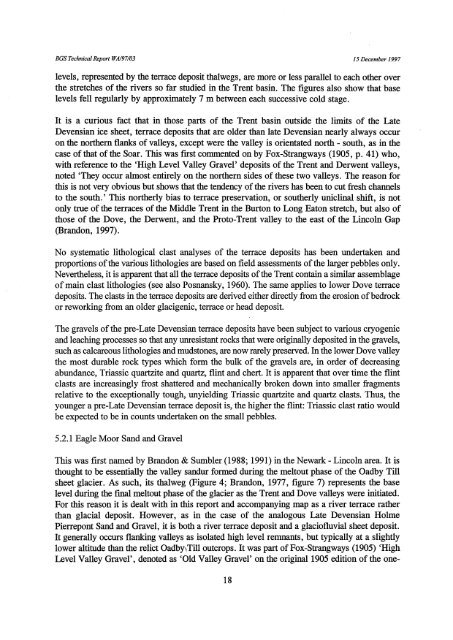Download (3723Kb) - NERC Open Research Archive - Natural ...
Download (3723Kb) - NERC Open Research Archive - Natural ...
Download (3723Kb) - NERC Open Research Archive - Natural ...
You also want an ePaper? Increase the reach of your titles
YUMPU automatically turns print PDFs into web optimized ePapers that Google loves.
BGS Technical Report WM97/03 15 December 1997<br />
levels, represented by the terrace deposit thalwegs, are more or less parallel to each other over<br />
the stretches of the rivers so far studied in the Trent basin. The figures also show that base<br />
levels fell regularly by approximately 7 m between each successive cold stage.<br />
It is a curious fact that in those parts of the Trent basin outside the limits of the Late<br />
Devensian ice sheet, terrace deposits that are older than late Devensian nearly always occur<br />
on the northern flanks of valleys, except were the valley is orientated north - south, as in the<br />
case of that of the Soar. This was fEst commented on by Fox-Strangways (1905, p. 41) who,<br />
with reference to the ‘High Level Valley Gravel’ deposits of the Trent and Derwent valleys,<br />
noted ‘They occur almost entirely on the northern sides of these two valleys. The reason for<br />
this is not very obvious but shows that the tendency of the rivers has been to cut fresh channels<br />
to the south.’ This northerly bias to terrace preservation, or southerly uniclinal shift, is not<br />
only true of the terraces of the Middle Trent in the Burton to Long Eaton stretch, but also of<br />
those of the Dove, the Derwent, and the Proto-Trent valley to the east of the Lincoln Gap<br />
(Brandon, 1997).<br />
No systematic lithological clast analyses of the terrace deposits has been undertaken and<br />
proportions of the various lithologies are based on field assessments of the larger pebbles only.<br />
Nevertheless, it is apparent that all the terrace deposits of the Trent contain a similar assemblage<br />
of main clast lithologies (see also Posnansky, 1960). The same applies to lower Dove terrace<br />
deposits. The clasts in the terrace deposits are derived either directly from the erosion of bedrock<br />
or reworking from an older glacigenic, terrace or head deposit.<br />
The gravels of the pre-Late Devensian terrace deposits have been subject to various cryogenic<br />
and leaching processes so that any unresistant rocks that were originally deposited in the gravels,<br />
such as calcareous lithologies and mudstones, are now rarely preserved. In the lower Dove valley<br />
the most durable rock types which form the bulk of the gravels are, in order of decreasing<br />
abundance, Triassic quartzite and quartz, flint and chert. It is apparent that over time the flint<br />
clasts are increasingly frost shattered and mechanically broken down into smaller fragments<br />
relative to the exceptionally tough, unyielding Triassic quartzite and quartz clasts. Thus, the<br />
younger a pre-Late Devensian terrace deposit is, the higher the flint: Triassic clast ratio would<br />
be expected to be in counts undertaken on the small pebbles.<br />
5.2.1 Eagle Moor Sand and Gravel<br />
This was first named by Brandon & Sumbler (1 988; 199 1) in the Newark - Lincoln area. It is<br />
thought to be essentially the valley sandur formed during the meltout phase of the Oadby Till<br />
sheet glacier. As such, its thalweg (Figure 4; Brandon, 1977, figure 7) represents the base<br />
level during the final meltout phase of the glacier as the Trent and Dove valleys were initiated.<br />
For this reason it is dealt with in this report and accompanying map as a river terrace rather<br />
than glacial deposit. However, as in the case of the analogous Late Devensian Holme<br />
Pierrepont Sand and Gravel, it is both a river terrace deposit and a glaciofluvial sheet deposit.<br />
It generally occurs flanking valleys as isolated high level remnants, but typically at a slightly<br />
lower altitude than the relict Oadby,Till outcrops. It was part of Fox-Strangways (1905) ‘High<br />
Level Valley Gravel’, denoted as ‘Old Valley Gravel’ on the original 1905 edition of the one-<br />
18
















